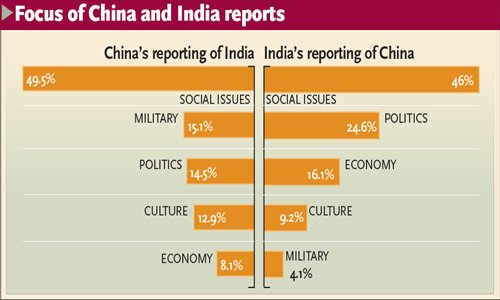HOME >> WORLD
Accentuating the positive
By Ling Yuhuan and Sun Xiaobo Source:Global Times Published: 2013-8-21 2:28:01

Two Chinese children pose with an Indian sailor while visiting Indian frigate Shivalik on June 16, 2012 during the visit by the Indian navy to Shanghai. Photo: CFP

The population of China and India, if combined together, tops 2.5 billion, but there are only about 20 correspondents stationed in each other's country. Experts say the disproportionate number of correspondents obviously cannot satisfy Chinese and Indian people's curiosity for each other.
A survey conducted by the Global Times Global Poll Center and released on Sunday showed the number of reports on China increased in six out of 10 surveyed Indian media outlets from 2010 to 2012, whereas reports on India are decreasing yearly in seven Chinese media outlets. The survey was based on reports from 10 influential newspapers and news agencies from China and India over the last three years.
Negative reporting on China is seen more frequently in Indian media than negative reporting on India in Chinese media, said the survey.
According to the survey, about 16.2 percent of Chinese media's reports on India have a positive perspective, while negative reports on India account for only 1 percent.
However, as many as 9.5 percent of Indian media reports on China have a negative perspective, and mainly focus on the India-China border disputes and China's geopolitical issues, said the survey. Positive reporting on China only accounts for 4.2 percent in the Indian media, it said.
The survey also indicated that border disputes between China and India have dominated Indian media's reporting of China. It said that apart from "China" and "India," "border" is the most common word used in headlines of Indian media reports on China, appearing in the headlines of 17.8 percent of all reports.
While Chinese media often use positive words or phrases such as "cooperation," "hand in hand" and "mutual" in reporting on India, the survey said negative words like "aggression," "intrusion" and "provoke" are more commonly used in Indian reports on China-India relations.
Western influence
"The biggest irritant in Sino-India relations is the baggage of history. The 1962 Sino-Indian War and India's humiliating defeat still rankle people in India. The Indian wound is still raw," Rajeev Sharma, a New Delhi-based journalist-author, told the Global Times.
Because of a lack of proficiency in the Chinese language, many Indian media outlets have to depend on reports by Western media and hence tend to view China from a Western perspective, Hu Shisheng, an expert on South Asia research at the China Institute of Contemporary International Relations, told the Global Times.
"India has been unavoidably affected by the Western media, which often takes a partial perspective when reporting on China. That partly explains why negative reporting on China is so common in Indian media," he said.
Outdated images
The survey said most Chinese media reports on India are about reciprocal visits by Chinese and Indian officials, entrepreneurs and organizations, whereas border disputes are less frequently reported.
However, experts noted that some Chinese media reports are also biased.
"Incorrect commentaries and alarmist reports appear across both sides of the border, not just one," M.D. Nalapat, vice chair of the Manipal Advanced Research Group in Manipal University, told the Global Times.
Rajiv Theodore, former head of the economic wing of United News of India, told the Global Times that a lack of comprehensive understanding of India can be easily detected in some Chinese media reporting.
"India is seen in China as a country dominated by backwardness, poverty, bad infrastructure and a scarcity of essential goods, despite the fact that Buddhism makes India a holy place for many Chinese," he said.
"Partial reporting by fueling negative perceptions can bring pressure on policy makers to go slow on forward movement in the relationship," Sunjoy Joshi, director of the Observer Research Foundation, told the Global Times.
Joshi added that negative perceptions or biases fueled by partial reporting would also influence how Chinese and Indian people see each other.
A survey released by The Hindu in May showed that as many as 84 percent of Indians believe China poses a threat, with 60 percent identifying China as a major threat.
According to the survey by the Global Times Global Poll Center, social issues are the most common topics in both Chinese and Indian media reports on each other.
It also showed that there are wider gaps between the numbers of reports on other topics in Indian media than their Chinese counterparts, with 24.6 percent of Indian reports on the second most widely covered topic, China's politics, and only 4.1 percent on the fifth most widely covered topic, China's military.
Interestingly, the survey noted that "US" is another very common word seen in Indian reports about China, which has appeared 52 times in the headlines of 1,324 reports.
Enhancing media exchanges
Lack of mutual access and restricted levels of engagement are factors leading to stereotypes of Chinese and Indian media, noted Joshi.
Although Chinese citizens going abroad reached a record 83.1 million last year, only 140,000 of them visited India, the Beijing-based Legal Daily reported. The number is much lower than that of Indians visiting China, which stood at about 600,000 in 2012.
"Greater interaction between citizens of both countries and perhaps more interaction between journalists of both countries are something which could definitely help to dispel misunderstandings," Tridivesh Singh Maini, a research fellow with the Sonepat-based Jindal School of International Affairs, told the Global Times.
"What is needed is a significant increase in reporting of either country by the other, and this is possible only when the number of Chinese journalists in India and Indian journalists in China rises to a reasonable number of at least 75 in either location," said Nalapat.
"Chinese television channels should also get beamed into India and get looked at the way British or US channels are, and vice versa," he added.
During Chinese Premier Li Keqiang's India visit, China and India agreed to increase media exchanges and to hold an India-China High Level Media Forum.
"Journalists need to be treated as brand ambassadors by the two sides. They are not warmongers. They simply hold the mirror to society and show the reality - good, bad or ugly," said Rajeev Sharma.
Posted in: Asia in Focus